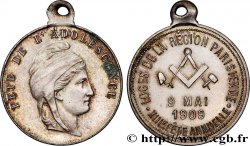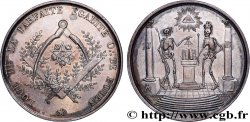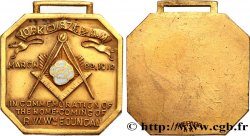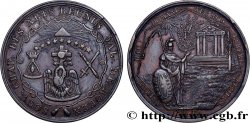fjt_514497 - FREEMASONRY L’AGE D’OR 1821
Not available.
Item sold on our e-shop (2019)
Price : 450.00 €
Item sold on our e-shop (2019)
Price : 450.00 €
Type : L’AGE D’OR
Date: 1821
Metal : gilt copper
Diameter : 88 mm
Orientation dies : 12 h.
Weight : 30,32 g.
Edge : Lisse
Rarity : INÉDIT
Coments on the condition:
Bijou dans sa boite d’origine
Predigree :
Exemplaire provenant de la Collection JCT
Obverse
Obverse legend : O :. DE PARIS L :. L’AGE D’OR 9ME J :. DU 10ME M :. 5783. / 1821.
Obverse description : Étoile à six branches rayonnante, (triangle pointe en haut superposé à triangle pointe en bas), ou Sceau de Salomon aux terminaisons de boules et flammes sur chaque pointe. Au centre Delta qui intègre le tétragramme et lettres divines ; inscriptions sur chaque coté du triangle : AETAS / AUREA / REDIVIVA. .
Obverse translation : La renaissance de l’Age d’Or.
Reverse
Commentary
Nous savons peu de choses de la Loge parisienne de l'Age d'Or. Bésuchet signale dans son Précis qu'elle fut fondée en 1783, ce qui est inscrit sur ce bijou. Ce bijou fut crée en 1821, lorsque la loge accusait alors 38 ans. La demande de constitution le 9 décembre 1783, fut acceptée le 4 février, installation le 16 mars suivant. Reprise d’activité en mars 1802. (
Source : Alain Le BIHAN. Mémoires et documents XIX ; Francs-Maçons Parisiens du GODF (fin du XVIII° siècle).
Loge inédite au Labouret.
We know little about the Parisian Lodge of the Golden Age. Bésuchet states in his Précis that it was founded in 1783, which is inscribed on this jewel. This jewel was created in 1821, when the lodge was then 38 years old. The request for constitution on December 9, 1783, was accepted on February 4, installation on the following March 16. Resumption of activity in March 1802. (Source: Alain Le BIHAN. Memoirs and documents XIX; Parisian Freemasons of the GODF (end of the 18th century). Unpublished lodge at Labouret
Source : Alain Le BIHAN. Mémoires et documents XIX ; Francs-Maçons Parisiens du GODF (fin du XVIII° siècle).
Loge inédite au Labouret.
We know little about the Parisian Lodge of the Golden Age. Bésuchet states in his Précis that it was founded in 1783, which is inscribed on this jewel. This jewel was created in 1821, when the lodge was then 38 years old. The request for constitution on December 9, 1783, was accepted on February 4, installation on the following March 16. Resumption of activity in March 1802. (Source: Alain Le BIHAN. Memoirs and documents XIX; Parisian Freemasons of the GODF (end of the 18th century). Unpublished lodge at Labouret








 Report a mistake
Report a mistake Print the page
Print the page Share my selection
Share my selection Ask a question
Ask a question Consign / sell
Consign / sell
 Full data
Full data









